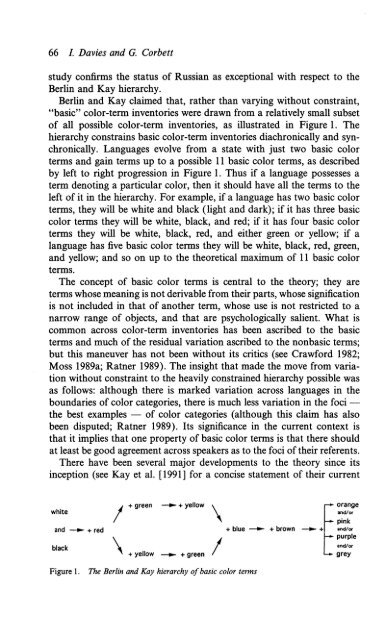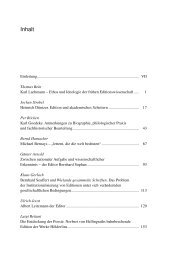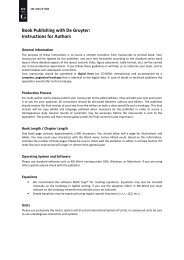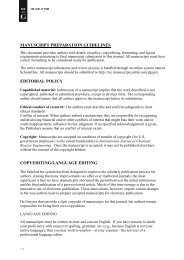The basic color terms of Russian* - Walter de Gruyter
The basic color terms of Russian* - Walter de Gruyter
The basic color terms of Russian* - Walter de Gruyter
Create successful ePaper yourself
Turn your PDF publications into a flip-book with our unique Google optimized e-Paper software.
66 /. Davies and G. Corbett<br />
study confirms the status <strong>of</strong> Russian as exceptional with respect to the<br />
Berlin and Kay hierarchy.<br />
Berlin and Kay claimed that, rather than varying without constraint,<br />
"<strong>basic</strong>" <strong>color</strong>-term inventories were drawn from a relatively small subset<br />
<strong>of</strong> all possible <strong>color</strong>-term inventories, as illustrated in Figure 1. <strong>The</strong><br />
hierarchy constrains <strong>basic</strong> <strong>color</strong>-term inventories diachronically and synchronically.<br />
Languages evolve from a state with just two <strong>basic</strong> <strong>color</strong><br />
<strong>terms</strong> and gain <strong>terms</strong> up to a possible 11 <strong>basic</strong> <strong>color</strong> <strong>terms</strong>, as <strong>de</strong>scribed<br />
by left to right progression in Figure 1. Thus if a language possesses a<br />
term <strong>de</strong>noting a particular <strong>color</strong>, then it should have all the <strong>terms</strong> to the<br />
left <strong>of</strong> it in the hierarchy. For example, if a language has two <strong>basic</strong> <strong>color</strong><br />
<strong>terms</strong>, they will be white and black (light and dark); if it has three <strong>basic</strong><br />
<strong>color</strong> <strong>terms</strong> they will be white, black, and red; if it has four <strong>basic</strong> <strong>color</strong><br />
<strong>terms</strong> they will be white, black, red, and either green or yellow; if a<br />
language has five <strong>basic</strong> <strong>color</strong> <strong>terms</strong> they will be white, black, red, green,<br />
and yellow; and so on up to the theoretical maximum <strong>of</strong> 11 <strong>basic</strong> <strong>color</strong><br />
<strong>terms</strong>.<br />
<strong>The</strong> concept <strong>of</strong> <strong>basic</strong> <strong>color</strong> <strong>terms</strong> is central to the theory; they are<br />
<strong>terms</strong> whose meaning is not <strong>de</strong>rivable from their parts, whose signification<br />
is not inclu<strong>de</strong>d in that <strong>of</strong> another term, whose use is not restricted to a<br />
narrow range <strong>of</strong> objects, and that are psychologically salient. What is<br />
common across <strong>color</strong>-term inventories has been ascribed to the <strong>basic</strong><br />
<strong>terms</strong> and much <strong>of</strong> the residual variation ascribed to the non<strong>basic</strong> <strong>terms</strong>;<br />
but this maneuver has not been without its critics (see Crawford 1982;<br />
Moss 1989a; Ratner 1989). <strong>The</strong> insight that ma<strong>de</strong> the move from variation<br />
without constraint to the heavily constrained hierarchy possible was<br />
as follows: although there is marked variation across languages in the<br />
boundaries <strong>of</strong> <strong>color</strong> categories, there is much less variation in the foci —<br />
the best examples — <strong>of</strong> <strong>color</strong> categories (although this claim has also<br />
been disputed; Ratner 1989). Its significance in the current context is<br />
that it implies that one property <strong>of</strong> <strong>basic</strong> <strong>color</strong> <strong>terms</strong> is that there should<br />
at least be good agreement across speakers as to the foci <strong>of</strong> their referents.<br />
<strong>The</strong>re have been several major <strong>de</strong>velopments to the theory since its<br />
inception (see Kay et al. [1991] for a concise statement <strong>of</strong> their current<br />
white<br />
j + green —*- + yellow v<br />
and —*- + red + blue —*~ + brown<br />
black<br />
* + yellow —»~ + green /<br />
Figure 1. <strong>The</strong> Berlin and Kay hierarchy <strong>of</strong> <strong>basic</strong> <strong>color</strong> <strong>terms</strong><br />
[-»· orange<br />
and/or<br />
>-»· pink<br />
and/or<br />
-*· purple<br />
and/or<br />
-*· grey
















